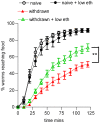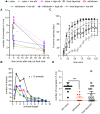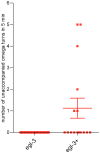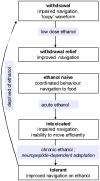A differential role for neuropeptides in acute and chronic adaptive responses to alcohol: behavioural and genetic analysis in Caenorhabditis elegans
- PMID: 20454655
- PMCID: PMC2862703
- DOI: 10.1371/journal.pone.0010422
A differential role for neuropeptides in acute and chronic adaptive responses to alcohol: behavioural and genetic analysis in Caenorhabditis elegans
Abstract
Prolonged alcohol consumption in humans followed by abstinence precipitates a withdrawal syndrome consisting of anxiety, agitation and in severe cases, seizures. Withdrawal is relieved by a low dose of alcohol, a negative reinforcement that contributes to alcohol dependency. This phenomenon of 'withdrawal relief' provides evidence of an ethanol-induced adaptation which resets the balance of signalling in neural circuits. We have used this as a criterion to distinguish between direct and indirect ethanol-induced adaptive behavioural responses in C. elegans with the goal of investigating the genetic basis of ethanol-induced neural plasticity. The paradigm employs a 'food race assay' which tests sensorimotor performance of animals acutely and chronically treated with ethanol. We describe a multifaceted C. elegans 'withdrawal syndrome'. One feature, decrease reversal frequency is not relieved by a low dose of ethanol and most likely results from an indirect adaptation to ethanol caused by inhibition of feeding and a food-deprived behavioural state. However another aspect, an aberrant behaviour consisting of spontaneous deep body bends, did show withdrawal relief and therefore we suggest this is the expression of ethanol-induced plasticity. The potassium channel, slo-1, which is a candidate ethanol effector in C. elegans, is not required for the responses described here. However a mutant deficient in neuropeptides, egl-3, is resistant to withdrawal (although it still exhibits acute responses to ethanol). This dependence on neuropeptides does not involve the NPY-like receptor npr-1, previously implicated in C. elegans ethanol withdrawal. Therefore other neuropeptide pathways mediate this effect. These data resonate with mammalian studies which report involvement of a number of neuropeptides in chronic responses to alcohol including corticotrophin-releasing-factor (CRF), opioids, tachykinins as well as NPY. This suggests an evolutionarily conserved role for neuropeptides in ethanol-induced plasticity and opens the way for a genetic analysis of the effects of alcohol on a simple model system.
Conflict of interest statement
Figures













Similar articles
-
Behavioral Deficits Following Withdrawal from Chronic Ethanol Are Influenced by SLO Channel Function in Caenorhabditis elegans.Genetics. 2017 Jul;206(3):1445-1458. doi: 10.1534/genetics.116.193102. Epub 2017 May 25. Genetics. 2017. PMID: 28546434 Free PMC article.
-
Natural variation in the npr-1 gene modifies ethanol responses of wild strains of C. elegans.Neuron. 2004 Jun 10;42(5):731-43. doi: 10.1016/j.neuron.2004.05.004. Neuron. 2004. PMID: 15182714
-
Distinct molecular targets including SLO-1 and gap junctions are engaged across a continuum of ethanol concentrations in Caenorhabditis elegans.FASEB J. 2013 Oct;27(10):4266-78. doi: 10.1096/fj.11-189340. Epub 2013 Jul 23. FASEB J. 2013. PMID: 23882127 Free PMC article.
-
Nematodes feel a craving--using Caenorhabditis elegans as a model to study alcohol addiction.Neurosci Bull. 2014 Aug;30(4):595-600. doi: 10.1007/s12264-014-1451-7. Epub 2014 Jul 9. Neurosci Bull. 2014. PMID: 25008572 Free PMC article. Review.
-
Ethanol.WormBook. 2010 Apr 29:1-6. doi: 10.1895/wormbook.1.40.1. WormBook. 2010. PMID: 20432508 Free PMC article. Review.
Cited by
-
Meeting report: 2012 Caenorhabditis elegans Neurobiology meeting, EMBL Advanced Training Centre, Germany.Invert Neurosci. 2013 Jun;13(1):85-90. doi: 10.1007/s10158-012-0146-5. Epub 2012 Dec 15. Invert Neurosci. 2013. PMID: 23242591
-
Alcohol disinhibition of behaviors in C. elegans.PLoS One. 2014 Mar 28;9(3):e92965. doi: 10.1371/journal.pone.0092965. eCollection 2014. PLoS One. 2014. PMID: 24681782 Free PMC article.
-
Multiple excitatory and inhibitory neural signals converge to fine-tune Caenorhabditis elegans feeding to food availability.FASEB J. 2016 Feb;30(2):836-48. doi: 10.1096/fj.15-279257. Epub 2015 Oct 29. FASEB J. 2016. PMID: 26514165 Free PMC article.
-
Caenorhabditis elegans dnj-14, the orthologue of the DNAJC5 gene mutated in adult onset neuronal ceroid lipofuscinosis, provides a new platform for neuroprotective drug screening and identifies a SIR-2.1-independent action of resveratrol.Hum Mol Genet. 2014 Nov 15;23(22):5916-27. doi: 10.1093/hmg/ddu316. Epub 2014 Jun 19. Hum Mol Genet. 2014. PMID: 24947438 Free PMC article.
-
C. elegans and mutants with chronic nicotine exposure as a novel model of cancer phenotype.Cancer Biol Ther. 2016;17(1):91-103. doi: 10.1080/15384047.2015.1108495. Cancer Biol Ther. 2016. PMID: 26574927 Free PMC article.
References
-
- DSM-IV. Diagnostic and Statistical Manual of Mental Disorders of the American Psychiatric Association. 1994. Washington DC.
-
- Weiss F. Neurocircuitry targets in ethanol reward and dependence. Alcohol Clin Exp Res. 1998;22:3–9. - PubMed
-
- Heinz A, Schäfer M, Higley JD, Krystal JH, Goldman D. Neurobiological correlates of the disposition and maintenance of alcoholism. Pharmacopsychiatry. 2003;Suppl 3:S255–S258. - PubMed
-
- Koob GF, Le Moal M. London: Elsevier Inc; 2006. Alcohol. pp. 173–241. In: Neurobiology of Addiction, Koob GF, Le Moal M.
Publication types
MeSH terms
Substances
Grants and funding
LinkOut - more resources
Full Text Sources
Other Literature Sources
Miscellaneous

